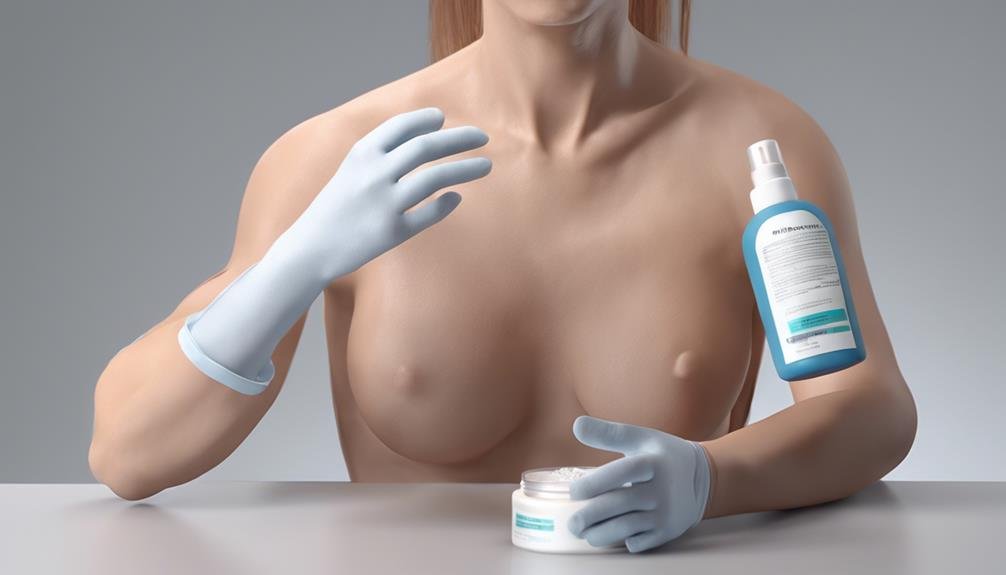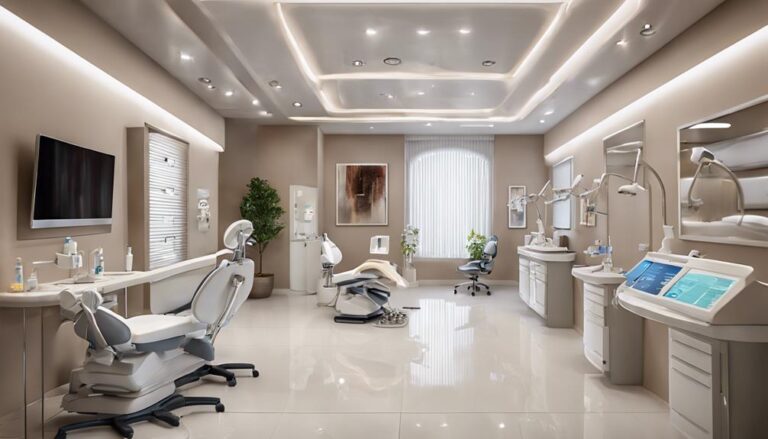Hyperhidrosis Treatment Options: Managing Excessive Sweating
When it comes to managing excessive sweating, maneuvering through the array of hyperhidrosis treatment options can be overwhelming. From topical solutions to more invasive procedures, the spectrum of choices offers a range of strategies to combat this common condition. But how do you determine which approach is best suited for your specific situation? Understanding the nuances of each treatment modality and their effectiveness is essential in finding the most suitable path towards alleviating the challenges posed by hyperhidrosis.
Key Takeaways
- Antiperspirants are first-line treatment, blocking sweat glands with aluminum chloride.
- Iontophoresis uses electrical currents to reduce sweating at home.
- Botox injections for long-lasting relief by blocking sweat gland nerves.
- Oral medications like anticholinergics and beta-blockers provide systemic relief.
- Lifestyle modifications include diet, hydration, and stress management for managing hyperhidrosis.
Antiperspirants
When considering hyperhidrosis treatment options, antiperspirants are often the first line of defense against excessive sweating. Antiperspirants work by blocking the sweat glands, reducing the amount of sweat that reaches the skin's surface. The active ingredient in antiperspirants, typically aluminum chloride, plays an important role in this process.
Sweat glands are responsible for producing sweat, which helps regulate body temperature. In individuals with hyperhidrosis, these sweat glands are overactive, leading to excessive sweating beyond what's necessary for thermoregulation. Antiperspirants containing aluminum chloride work by forming temporary plugs in the sweat gland ducts, reducing the flow of sweat to the skin's surface.
For those dealing with hyperhidrosis, using antiperspirants can be an effective initial treatment option. It's essential to apply antiperspirants to clean, dry skin before bedtime to allow the active ingredients to work overnight. While antiperspirants may not completely eliminate sweating, they can greatly reduce the amount of sweat produced, providing relief for individuals with hyperhidrosis.
Medications
Medications prescribed for hyperhidrosis often target the overactive sweat glands to reduce excessive sweating. Topical solutions are commonly used in the form of anticholinergics or aluminum-based compounds. Anticholinergics like glycopyrrolate work by blocking the neurotransmitter acetylcholine, which stimulates sweat production. Aluminum-based compounds, found in many over-the-counter antiperspirants, form temporary plugs in the sweat ducts to reduce sweating. These topical solutions are typically the first line of treatment due to their convenience and minimal side effects.
In addition to traditional medications, alternative therapies like oral anticholinergic medications may be prescribed for more severe cases of hyperhidrosis. These medications, such as oxybutynin, can help reduce sweating by inhibiting the activation of sweat glands throughout the body. However, they may come with more side effects compared to topical solutions. It is essential to consult with a healthcare professional to determine the most suitable medication or therapy based on individual needs.
| Type of Medication | Examples |
|---|---|
| Topical Solutions | Anticholinergics |
| Aluminum-based compounds | |
| Alternative Therapies | Oral anticholinergic medications |
Iontophoresis
To address hyperhidrosis beyond medications, iontophoresis uses mild electrical currents to reduce excessive sweating. This treatment involves placing the affected areas, commonly the hands, feet, or underarms, in water while a low electrical current passes through. The exact mechanism isn't fully understood, but it's believed that iontophoresis helps block sweat ducts temporarily, reducing sweat production.
Iontophoresis is a non-invasive procedure that can be done at home with a proper device or at a healthcare provider's office. The treatment typically requires multiple sessions for effectiveness, followed by a maintenance schedule. It's vital to maintain good skin care during iontophoresis to prevent any skin irritation or burns.
During iontophoresis, it's important to pay attention to your electrolyte balance to ensure the treatment's safety and effectiveness. Electrolytes are essential minerals that help regulate various bodily functions, including nerve and muscle function. Monitoring your electrolyte levels, especially if you have certain medical conditions or are taking medications that affect electrolytes, is crucial when undergoing iontophoresis treatment.
Botox Injections
Botox injections, a popular treatment for hyperhidrosis, involve administering botulinum toxin to target sweat glands and reduce excessive sweating. The procedure is performed by injecting small amounts of Botox into the skin in areas where hyperhidrosis is most problematic, such as the underarms, palms, or soles of the feet. This neurotoxin works by blocking the nerves that stimulate sweat production, leading to a significant decrease in sweat production.
When considering Botox injections for hyperhidrosis, it's important to be aware of potential side effects. Common side effects may include temporary pain or bruising at the injection site, as well as minor swelling or redness. In rare cases, patients may experience muscle weakness or difficulty swallowing, which should be reported to a healthcare provider immediately.
The longevity of results with Botox injections for hyperhidrosis typically lasts around 4 to 14 months, depending on the individual. To maintain the effects, follow-up injections are usually required. Botox injections can provide significant relief for those struggling with excessive sweating, offering a temporary solution with noticeable results.
Oral Medications
When seeking relief from excessive sweating, oral medications can offer a viable solution.
Prescription anticholinergics work by blocking the chemical messenger acetylcholine, which stimulates sweat glands.
Beta-blockers, commonly used for anxiety, can also help reduce sweating by blocking adrenaline.
Prescription Anticholinergics
Anticholinergic oral medications are commonly prescribed to help manage the symptoms of hyperhidrosis. These medications work by blocking the action of acetylcholine, a neurotransmitter that stimulates sweat gland activity.
Here are three key points to keep in mind when using prescription anticholinergics for hyperhidrosis:
- Dosage Adjustment: Finding the right dosage is essential to balancing the effectiveness of the medication with potential side effects. Your healthcare provider will determine the best dose based on your individual needs and response to the medication.
- Monitoring Side Effects: Anticholinergics can cause dry mouth, constipation, blurred vision, and cognitive issues like memory problems. It's important to communicate any side effects to your doctor promptly to make necessary adjustments.
- Interaction with Other Medications: Anticholinergics may interact with certain medications like muscle relaxants or antihistamines, leading to increased side effects. Inform your healthcare provider about all the medications you're taking to avoid potential interactions.
Beta-Blockers for Anxiety
To manage anxiety, consider exploring the use of beta-blockers as oral medications, which can help alleviate physical symptoms associated with the condition. Beta-blockers work by blocking the effects of adrenaline, reducing heart rate, blood pressure, and tremors that can be triggered by anxiety. These medications are often prescribed for situational anxiety, such as before a public speaking event or an important meeting. Please be aware that beta-blockers do not treat the underlying psychological causes of anxiety, so they are usually used in conjunction with other therapies like cognitive therapy or relaxation techniques.
| Beta-Blockers for Anxiety | Description |
|---|---|
| Propranolol | Reduces heart rate and tremors |
| Atenolol | Lowers blood pressure |
| Metoprolol | Helps control heart rhythm |
| Nadolol | Used for performance anxiety |
| Bisoprolol | Alleviates physical symptoms |
When considering beta-blockers for anxiety, consult with a healthcare provider to determine the most suitable medication and dosage for your specific needs. Remember to combine medication with therapy or relaxation techniques for thorough anxiety management.
Surgery
Surgical interventions are considered for individuals with hyperhidrosis when other treatment options haven't provided sufficient relief from excessive sweating. When exploring surgical options, it's important to understand the following:
- Endoscopic Thoracic Sympathectomy (ETS): ETS is a minimally invasive surgical procedure where the sympathetic nerves responsible for triggering excessive sweating are cut. While ETS can provide effective results, it may lead to compensatory sweating in other areas of the body.
- Laser Sweat Ablation: This procedure involves using a laser to destroy the sweat glands in the armpits. It offers a permanent solution for axillary hyperhidrosis and has a lower risk of compensatory sweating compared to ETS.
- Sweat Gland Removal: In cases where other methods aren't suitable, surgically removing sweat glands in the armpits can be an option. This approach provides a permanent solution but may lead to scarring and potential risks associated with any surgical procedure.
Microwave Thermolysis
Utilizing microwave thermolysis involves applying targeted heat to the sweat glands, effectively reducing their activity and addressing hyperhidrosis. This treatment option is gaining popularity due to its minimally invasive nature and promising results. One of the key benefits of microwave thermolysis is its ability to provide long-lasting relief from excessive sweating with relatively few side effects. Research has shown that patients experience a significant reduction in sweating after undergoing microwave thermolysis, improving their quality of life.
While microwave thermolysis is generally safe, like any medical procedure, it does carry some risks. Potential side effects may include temporary discomfort, swelling, or skin irritation at the treatment site. However, these effects are usually mild and subside quickly. It's essential to consult with a qualified healthcare provider to determine if microwave thermolysis is the right treatment option for your specific condition.
Recent studies have also explored the effectiveness of microwave thermolysis in different patient populations, showing promising results across various demographics. This ongoing research aims to further enhance the efficacy and safety of microwave thermolysis for individuals suffering from hyperhidrosis.
Laser Therapy
Applying targeted laser therapy is an innovative approach for addressing hyperhidrosis by precisely targeting and reducing sweat gland activity. Laser therapy effectiveness in treating hyperhidrosis has been demonstrated through studies showing a significant reduction in sweat production. However, as with any medical procedure, there are potential side effects to take into account, such as temporary discomfort, redness, or swelling at the treatment site.
Three key points to keep in mind regarding laser therapy for hyperhidrosis are:
- Effectiveness: Laser therapy has shown promising results in reducing sweat production in individuals with hyperhidrosis. The procedure targets specific sweat glands, leading to a noticeable decrease in excessive sweating over time.
- Side Effects: While generally safe, laser therapy may cause temporary side effects like skin irritation, blistering, or changes in skin pigmentation. It's crucial to discuss potential risks with a healthcare provider before undergoing treatment.
- Cost Comparison: When comparing laser therapy with alternative treatments like injections or oral medications, the cost can vary. Laser therapy may have a higher upfront cost but could be more cost-effective in the long run by providing lasting results with fewer maintenance sessions.
Lifestyle Changes
To manage hyperhidrosis through lifestyle changes, consider focusing on your diet and hydration levels, as certain foods and drinks can exacerbate sweating.
Additionally, opt for breathable fabrics and loose-fitting clothing to help regulate body temperature and reduce sweat production.
Engaging in stress-management techniques such as mindfulness or exercise can also aid in controlling excessive sweating triggered by emotional factors.
Diet and Hydration
Wondering how your diet and hydration can impact hyperhidrosis? Maintaining a proper nutritional balance and adequate hydration levels can play an important role in managing excessive sweating. Here are three key points to take into account:
- Nutritional Balance: Consuming a well-rounded diet rich in fruits, vegetables, whole grains, and lean proteins can help regulate your body's functions, potentially reducing the severity of hyperhidrosis. Certain foods like spicy dishes or caffeine may trigger sweating in some individuals, so keeping a food diary to identify any potential triggers could be beneficial.
- Hydration Levels: Staying hydrated is essential for overall health and can also influence sweating patterns. Dehydration can lead to an increase in body temperature, prompting your body to sweat more profusely. Aim to drink an adequate amount of water throughout the day to support your body's natural cooling mechanisms.
- Electrolyte Balance: Electrolytes like sodium, potassium, and magnesium play an important role in regulating fluid balance in the body. Ensuring you maintain proper electrolyte levels can help prevent imbalances that might exacerbate sweating. Consider incorporating electrolyte-rich foods or drinks into your diet, especially if you sweat excessively.
Clothing Choices
Maintaining proper clothing choices can greatly impact your experience with hyperhidrosis, influencing the severity of excessive sweating episodes. When selecting garments, opt for sweat-proof clothing made from breathable materials like cotton or moisture-wicking fabrics. These materials can help absorb moisture and allow your skin to breathe, reducing the discomfort caused by excessive sweating.
Dark colors and patterns can also be your allies, as they can help conceal any sweat marks that may occur. Loose-fitting clothes can aid in airflow, preventing sweat from accumulating on your skin and exacerbating your condition. Additionally, consider layering your clothing to easily remove and change if sweating becomes excessive.
Stress Management
Effective stress management plays a crucial role in managing the symptoms of hyperhidrosis through lifestyle changes. When stress levels are high, it can exacerbate sweating in individuals with hyperhidrosis. Implementing relaxation techniques and mindfulness practices can help reduce stress and improve the overall well-being of those dealing with excessive sweating.
To effectively manage stress and its impact on hyperhidrosis, consider the following lifestyle changes:
- Deep Breathing Exercises: Practice deep breathing techniques such as diaphragmatic breathing to help calm your body's stress response and reduce anxiety levels.
- Progressive Muscle Relaxation (PMR): Incorporate PMR into your daily routine to systematically tense and relax muscle groups, helping to release physical tension and promote relaxation.
- Mindfulness Meditation: Engage in mindfulness meditation to increase awareness of the present moment, reduce racing thoughts, and cultivate a sense of calmness that can positively impact stress levels and sweating patterns.
Conclusion
To sum up, managing excessive sweating through various treatment options can greatly improve quality of life for individuals with hyperhidrosis.
For example, Sarah, a 30-year-old teacher, struggled with embarrassing sweat stains until she tried Botox injections. Now, she can confidently interact with her students without worrying about excessive sweating.
By exploring different approaches and finding what works best for each individual, it's possible to effectively control hyperhidrosis and regain confidence in daily life.







